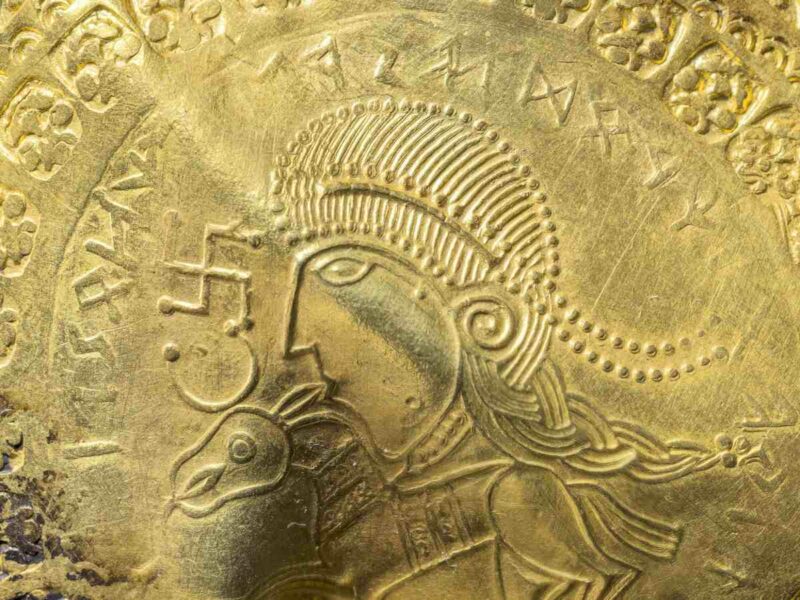Rediscovering Our Forgotten Roots
The Vindelev Hoard revised our knowledge of the past, most of which has been conspicuously forgotten despite being not that long ago. In my view, the relentless pursuit of the “new” by human groups leads them to systematically erase their own past.
In addition, a political struggle came about which ended with the Christianization of Europe, at which point any pagan artifacts were destroyed if not hidden away. It was as if the weaker of the species found an excuse to destroy their own societies.
Archaeologists now date this as the earliest observation of the god Odin, who was previously thought to be of recent origin, but now is confirmed in the fifth century:
Lisbeth Imer, a runologist with the National Museum in Copenhagen, said the inscription represented the first solid evidence of Odin being worshipped as early as the 5th century — at least 150 years earlier than the previous oldest known reference, which was on a brooch found in southern Germany and dated to the second half of the 6th century.
The disc discovered in Denmark was part of a trove containing about a kilogram (2.2 pounds) of gold, including large medallions the size of saucers and Roman coins made into jewelry. It was unearthed in the village of Vindelev, central Jutland, and dubbed the Vindelev Hoard.
Experts think the cache was buried 1,500 years ago, either to hide it from enemies or as a tribute to appease the gods. A golden bracteate — a kind of thin, ornamental pendant — carried an inscription that read, “He is Odin’s man,” likely referring to an unknown king or overlord.
Of course, these scientists are looking from a modern perspective of organized religion. Ancient religion was passed on through folk-tales as part of the culture, and went back thousands of years. Odin was probably worshiped for tens of thousands of years longer than our scientists imagine.
Even more, it seems as if most of our modern organized religion seems to be a retelling of this ancient religion — believed to be the proto-Indo-European faith, shared among all who became our modern Nordic/Cro-Magnid people — which features a self-sacrificing Allfather:
In Norse mythology the god Odin was the chief of all other deities who presided over Valhalla, the warrior’s paradise. In Norse myths Odin sacrificed his eye in Mimir’s well, he threw himself on his own spear Gungnir in a symbolic ritual suicide, and then he hung himself in Yggdrasil, the Norse tree of life for nine days and nine nights, in order to gain knowledge of other worlds and to be able to understand the meaning of runes.
Here we have the origins of fasting in the desert, ritual sacrifice of the god, and a form of monotheism in which the lesser gods were seen as independent forces instead of being abolished entirely. All of our modern religions descend from this idea.
Even more, as archaeology continues to find, modern humans date back further than we ever guessed. In my view, we are going to find hundreds of thousands or millions of years of modern humanity, with most obscured because they left few stone or metal relics.
These societies were not illiterate, as this bracteate demonstrates, but instead were suspicious of the word and other symbols because they could lead to mistaking the means of life for the ends of the individual who seeks knowledge and inner power instead of outer power.
Consequently, for them, writing everything down was not a priority; learning ancient knowledge and passing it along by voice was. As a result, whenever an interruption happened, the old knowledge was not abused by those who did not deserve it.
Most likely these people were nomadic until the rise of permanent civilizations forced them to settle in Europe, and left behind a certain portion of their population — waste humans and weaker people — each time they made a move, creating a natural form of eugenics.
Even more, we can see that they valued certain ancient symbols that we fear today:
The bracteate also displays a swastika, an ancient symbol used throughout the Iron Age and later co-opted by German nationalists and Adolf Hitler’s Nazi Party.
Odin appears in multiple pre-Christian barbarian belief systems across northern Europe in the centuries following the collapse of the Roman Empire in the west. He was known as Wōden to the Saxons who colonized England in the 5th and 6th centuries, and as Uuôden in Old Dutch.
Some traditions place him as the father or ruler of the gods. The Prose Edda, one of the main sources of Norse mythology, refers to Odin as the “Allfather.”
The swastika symbolizes the sun, the passage of time, and the battle-pattern adopted by these ancient warriors. Banning it because Hitler used it is as ridiculous as banning the cross because the Templars used it, or censoring hammers because they were part of the symbol of the biggest killers in history.
Even more, this tells us how deeply our society has decayed within while focusing on external power (money, technology, influence). Instead of people who have a clear idea of who we are and what we must do in order to live well, we are substituing the external for the internal.
Our social structures reflect this fact. We depend on control, or using external means-over-ends thinking in order to change internal dialogue, to keep our people united and behaving in the manner that fits within our egalitarian order.
At the same time, the ancient spirit and power lurks within us. All we must do is discard the stupid stuff based on the “Big Lie” of equality that we are doing now, and pursue these ancient inner ways, even while keeping our technology and wealth so that we can explore the stars.
Tags: history, odin, paganism, vindelev hoard










